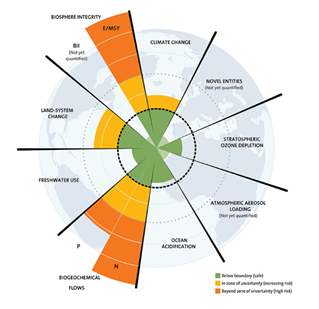A Climate Action Quick Start for Investors
According to the UN’s Convention on Biological Diversity the main drivers of biodiversity loss are habitat loss and degradation, climate change, pollution, over-exploitation, and invasive species.1 Habitat loss is directly linked to the conversion of natural ecosystems to agricultural lands and unsustainable use of water resources.
What is biodiversity?
The word biodiversity, a contraction itself of “biological diversity”, was coined by W. G. Rosen in 1985. Biodiversity is the variability amongst living organisms from all ecosystems on the planet, including terrestrial and marine ecological systems, including all diversity between species. More formally, biodiversity begins with differences in genes, then individual species, then communities of creatures and finally entire ecosystems, where life interplays with the physical environment.1
These interactions are crucial to keeping the planet healthy, specifically, the ecosystems humanity sorely relies on. COVID-19 has drawn further attention to the fact that maintaining biodiverse ecosystems is key to ensuring a healthy human activity, becoming very clear that there are links between disease outbreaks and the degradation of nature.2,3 Meanwhile, biodiversity is also a vital part of the solution to climate change, both in terms of protection from physical effects, for example via mangroves protecting coastlines from floods or through conserved or restored habitats absorbing and storing carbon.
Despite this, extinction risks and the encroaching loss of ecosystems are pushing biodiversity to the brink. The huge global biodiversity losses are rapidly representing a crisis equaling–or quite possibly exceeding–climate change.
Planetary boundaries
Currently, it is unclear what impacts these losses in biodiversity will have on the planet or whether it will lead to a more

significant ecological collapse. The concept of ‘planetary boundaries’ is one approach to understanding this better. This covers processes that regulate the stability and resilience of the Earth system. With nine boundaries in total, the system includes climate, land system change, water use and more. Of the nine different aspects, biogeochemical flows and biosphere integrity are already both deemed to be crossed, indicating the breaches in these areas are beyond a level of uncertainty in terms of risk.
How can investors get started on Climate Action?
At Sustainalytics, we deeply understand the importance of biodiversity within earth systems and seek to address these risks through our Thematic Engagement programs. Accordingly, to address biodiversity, the Stewardship Team engages companies on drivers across several planetary boundary topics, aiming to create positive impact through our Localized Water Management, Feeding the Future, and Climate Change - Sustainable Forests and Finance thematic engagements. Investors can join these three-year projects separately or by subscribing to our Biodiversity Bundle.
Climate Change - Sustainable Forests and Finance targets key actors throughout the forest value chain, striving to bring cross-sectoral dialogue and to identify and enable production and consumption strategies within planetary boundaries. Collaboration is key, as these challenges require entire value chains to work together to achieve transformative systemic change. With climate change as a severe threat to biodiversity, ensuring companies implement effective climate strategies is essential to protecting this. This engagement also seeks to drive action on deforestation and the growing interest in nature-related disclosures that will be standardized in the upcoming Taskforce on Nature-Related Financial Disclosures.
Feeding the Future aims at contributing to a more sustainable trajectory for food production. The global food system has a massive environmental footprint with significant and sometimes irreversible implications for biodiversity, and mega-trends such as population growth and climate change will put more pressure on already stretched resources. Engaged companies are to develop holistic responses to the environmental challenges of food production. This engagement also covers the entire value chain, including companies from agriculture, agricultural chemicals, packaged foods, and food retail industries.
The purpose of our Localized Water Management engagement is to have positive impacts on water management and environmental stewardship at both the company- and the more complex basin-level. Company-wide water management strategies are essential, but water security challenges happen at the locally and a corporate one-size-fits-all solution does not exist. Ensuring sustainable fresh water supply and consumption in a given basin is a task that requires collaboration between many stakeholders. Stable long-term water management at a basin level supports regional biodiversity. This engagement focuses on companies with operations in the Tiete basin in Brazil and the Vaal basin in South Africa.
While it is very positive that biodiversity loss is starting to get the same attention as climate change, it is high time to act – business as usual is not a viable option. Both companies and investors need to make sure their activities do not contribute to any harmful activities and are aligned with relevant biodiversity-related standards. Collaborative measures are often the most effective and efficient way to tackle shared challenges such as this.
If you would like to hear more about our stewardship programs in these areas, then please reach feel free to contact us here.
Sources:
1. https://www.theguardian.com/news/2018/mar/12/what-is-biodiversity-and-why-does-it-matter-to-us
2. https://e360.yale.edu/features/how_forest_loss_is_leading_to_a_rise_in_human_disease_malaria_zika_climate_change





